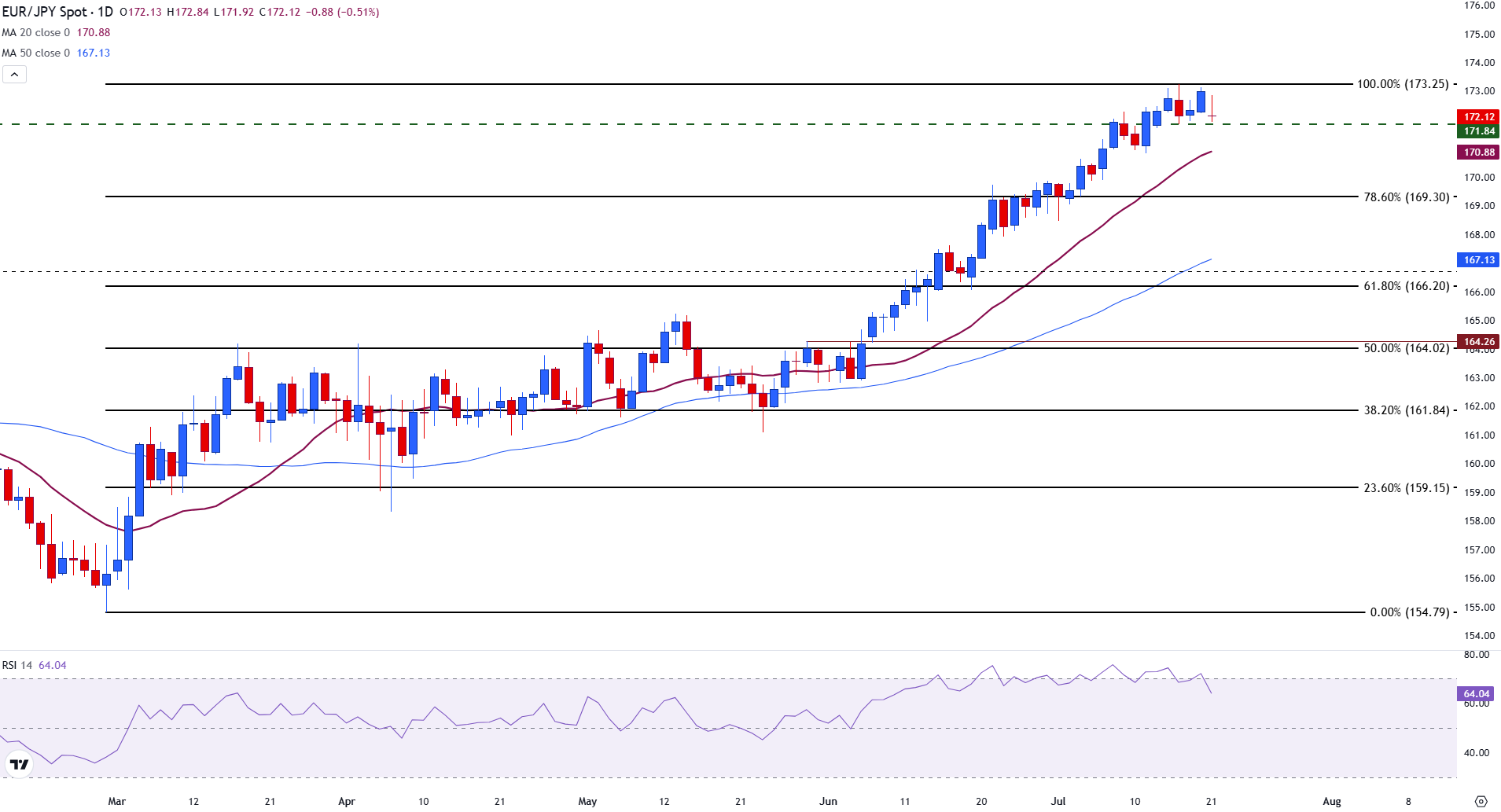EUR/JPY edges lower as EU-US trade tensions overshadow Japan's election results
- The Euro slips against the safe-haven Yen as EU–US trade risks escalate ahead of the ECB decision.
- Yen finds support as Ishiba holds power despite election setback.
- EUR/JPY edges lower as bullish momentum moderates below recent highs.
The Euro (EUR) is easing against the Japanese Yen (JPY) following Japan’s post-election clarity and renewed concerns over stalled EU–US trade negotiations.
At the time of writing, EUR/JPY is holding just above the 172.00 support level as bullish momentum shows signs of fading.
Yen finds support as Ishiba holds power despite election setback
Japan’s election outcome gave the Yen a temporary boost. Although Prime Minister Ishiba’s ruling coalition lost its slim upper‑house majority by three seats on Sunday, he’s likely to stay in power and could still advance legislation with backing from smaller parties.
Investors have welcomed this result, relieved that a low-tax opposition agenda may be averted and that Ishiba’s government remains in place to continue US trade negotiations ahead of the August 1 deadline.
Japan’s chief negotiator, Ryosei Akazawa, is expected to meet with US Treasury Secretary Scott Bessent and Commerce Secretary Howard Lutnick. Japan remains eager to de-escalate tensions and avoid a 25% reciprocal tariff that would target almost all of Japan's exports.
Euro under pressure as EU–US trade risks mount ahead of ECB decision
Meanwhile, the European Union (EU) is struggling to progress with its own trade talks with the US. With trade between the EU and the US totaling $1.96 trillion in 2024, US President Donald Trump intends to impose a baseline tariff of 15% to 20% on EU imports.
This would place significant pressure on the bloc’s members, especially the export-driven economies such as the EU’s largest economy, Germany.
Moreover, the European Central Bank’s (ECB) business survey, released on Monday, showed that Eurozone firms remain modestly optimistic. However, companies are seeing pressure on profit margins.
This reinforces expectations that the ECB will maintain a cautious stance at its upcoming rate decision on Thursday, potentially signaling a cut later this year.
The softening inflation outlook is weighing on the Euro and contributing to EUR/JPY’s pullback from recent highs.
EUR/JPY consolidates as bullish momentum moderates below recent highs
EUR/JPY pulled back on Monday after reaching a multi-year high near 173.25 last week. Price action is currently consolidating just above the 172.00 support zone.
The daily chart indicates that momentum is easing as the Relative Strength Index (RSI) exits overbought territory. While the pair holds above the 20-day Simple Moving Average (SMA) at 170.88, the underlying bullish structure remains intact.

EUR/JPY daily chart
A break below this level could expose deeper retracements toward 169.30 and 166.20, while a sustained move above 173.25 would open the door to fresh upside toward the 175.00 handle.
Tariffs FAQs
Tariffs are customs duties levied on certain merchandise imports or a category of products. Tariffs are designed to help local producers and manufacturers be more competitive in the market by providing a price advantage over similar goods that can be imported. Tariffs are widely used as tools of protectionism, along with trade barriers and import quotas.
Although tariffs and taxes both generate government revenue to fund public goods and services, they have several distinctions. Tariffs are prepaid at the port of entry, while taxes are paid at the time of purchase. Taxes are imposed on individual taxpayers and businesses, while tariffs are paid by importers.
There are two schools of thought among economists regarding the usage of tariffs. While some argue that tariffs are necessary to protect domestic industries and address trade imbalances, others see them as a harmful tool that could potentially drive prices higher over the long term and lead to a damaging trade war by encouraging tit-for-tat tariffs.
During the run-up to the presidential election in November 2024, Donald Trump made it clear that he intends to use tariffs to support the US economy and American producers. In 2024, Mexico, China and Canada accounted for 42% of total US imports. In this period, Mexico stood out as the top exporter with $466.6 billion, according to the US Census Bureau. Hence, Trump wants to focus on these three nations when imposing tariffs. He also plans to use the revenue generated through tariffs to lower personal income taxes.

